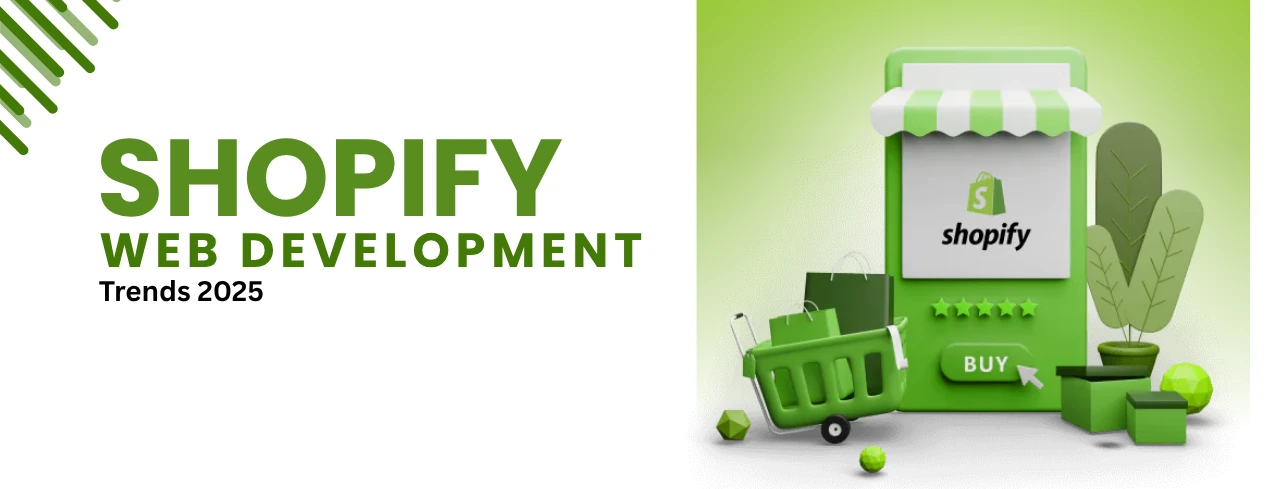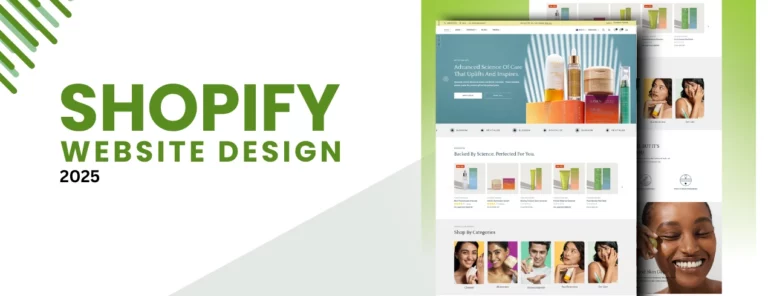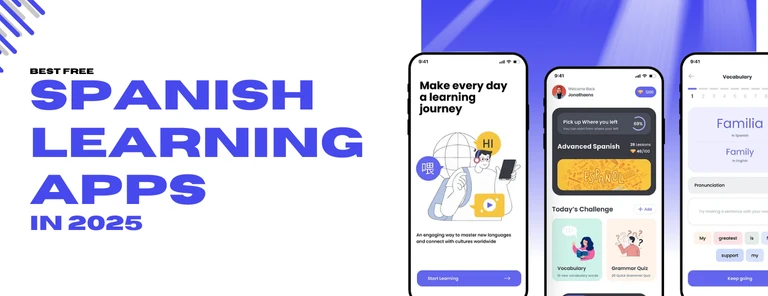In this dynamic environment of e-commerce, change is the only constant, and 2025 is coming close to being one of the most pivotal ones yet as far as Shopify web development is concerned. Modern customers are used to receiving personal suggestions, interactive visual experiences, super-fast load speed, and device-free interactions. These are the expectations that stores should live up to win attention and carts.
With products such as Shopify Magic, Hydrogen & Oxygen, and AI-powered storefronts, Shopify is transforming into a complete end-to-end commerce solution, giving businesses of all levels a chance to create sites that perform as well as the leading brands. However, in order to transcend the competition, merely embracing new tech is not enough since you have to use it strategically.
This guide will take an in-depth look at the best 2025 Shopify web development trends, how the best stores are leveraging them to boost conversion, loyalty, SEO, and mobile speed. And in the process, find out how you can use these strategies in your store, and how an intelligent Shopify web development company like DQOT Solutions can make them come to life in a professional, efficient way.
Here’s what the rest of the blog covers:
- Trend breakdowns: From AI to headless storefronts, bite‑sized and actionable
- Real-world examples: Introduction to stores already championing these approaches
- The way DQOT Solutions utilizes every trend, from implementation to making the Website Store delivery
- Tactical development guidance, plus FAQs to assist your next course of action
Now it is time to jump into Trend 1 and discuss how AI is revolutionizing Shopify stores today.
Table of Contents
Top Shopify Web Development Trends in 2025!

1. AI & Machine Learning Integration 🧠
Artificial intelligence is swiftly becoming a minimum requirement within e-commerce platforms, versus being a buzzword. Not integrating AI in Shopify web development in 2025 will mean leaving performance on the table.
What’s new in AI-powered commerce?
- Shopify Magic and AI-generated content: Shopify just introduced Magic and Sidekick, tools that work with AI to automate dozens of processes, including creating SEO-friendly product descriptions or intelligent discount codes and even email subject lines. Brands that employ these features claim a 15-30% increase in conversion and efficiency.
- Smart search and discovery: New acquisitions such as Vantage Discovery indicate the direction Shopify is headed in. An AI algorithm-based search and discovery tool that approaches predictive levels matching Pinterest.
- Personalized recommendations: Machine learning is used to analyze customer behavior to allow real-time upsells, cross-sells, and dynamic blocks of content to enhance average revenue per spend and consumer interaction.
- AI chatbots & support 24/7: The built-in chatbots can provide support 24/7, covering routine support questions, leaving human agents to cover the complex support services, with no additional staff needed to maintain a high level of customer satisfaction.
Why does AI matter for your store?
Integration of AI on your Shopify store increases productivity, customer engagement, and experience, ultimately increasing sales, loyalty, and ROI.
How DQOT Solutions brings AI to your store
DQOT Solutions develops Shopify web designs with well-integrated AI solutions, such as Magic-powered content blocks, intelligent search, and chatbots to be added to them. Under the guidance of DQOT Solutions, brands can reap the rewards of AI without being technically savvy, and each feature of AI can be customized to suit the design, brand, and conversion of your store.
2. Headless Commerce with Hydrogen & Oxygen ⚙️
The era of headless commerce is not limited to large enterprises anymore; it is quickly becoming a standard in high-productive Shopify web design. By 2025, a greater percentage of Shopify stores will be going headless to gain blazing fast speeds, incredibly distinctive layouts, and platform adaptability by separating the frontend (user interface) and backend (business logic).
What’s powering this shift?
Shopify’s Hydrogen (an open framework that allows developers to create custom storefronts using React) and Shopify’s Oxygen (a global hosting solution) provide developers with creative and technical freedom without intruding on performance. These tools set brands up to create immersive and app-like user experiences, while retaining all the benefits of the Backend and ecosystem that Shopify has to offer.
Why go headless?
- Speed & Performance: Headless sites load faster, which is essential in minimising bounce rates and maximising conversions.
- Design Flexibility: Create the type of storefront that you want with no limitations to its theme.
- Omnichannel Compatibility: Headless enables a natural fit on all devices, kiosks, apps, and even smart TVs.
Brands like Allbirds and the demo stores on Shopify have already established the trend, and many of the best Shopify web examples in fashion, lifestyle, and technology are already reaping the rewards.
DQOT Solutions’ approach to headless Shopify
DQOT Solutions is an expert in Shopify headless development, which is integrated into our Shopify e-commerce site development capabilities. When you want to create custom Shopify storefronts, we employ Hydrogen + Oxygen pairs with frameworks, such as Next.js and Tailwind CSS, to create storefronts that not only look great but also load quickly, respond to devices, and are properly scaled. Are you an all-volume vendor or a brand with complicated design needs? Our solutions allow you to obtain total control without compromise on the backend simplicity.
3. Progressive Web Apps (PWAs) & Single Page Apps (SPAs) 📱
Progressive Web Apps (PWAs) are becoming a transformation trend because the line between mobile websites and native applications is blurring. In 2025, the development of a PWA or SPA will be an effective method that brands utilizing the Shopify e-commerce platform can use to achieve fast, app-like experiences to shop without the expense of developing native apps.
Why do PWAs matter for Shopify stores?
- Instant Load Times: PWAs cache content and resources, so your site loads even on slow networks.
- Offline Capabilities: Shoppers are able to browse products offline even when they have a weak or no internet connection.
- Push Notifications: PWAs, similar to mobile applications, have push notifications for sales, cart abandonment, and notifications.
- App-Like Feel: PWAs increase engagement and retention with immersive transitions and smooth interactions.
Large Shopify businesses such as Flipkart and OLIPOP are taking this strategy to convert more mobile traffic, increase search engine results page (SERP) ranking, and minimize bounce rates.
What about SPAs?
Single Page Apps dynamically load all their contents, so the customers can browse your store without having to reload pages. This is a great enhancement to the user flow, reducing friction on the way to purchase.
Where does DQOT Solutions fit in?
At DQOT Solutions, we create Shopify storefronts empowered with PWA capability and SPA logic when your brand requires lightning-fast performance and mobile supremacy. Our developers build storefronts based on tools such as Gatsby.js, React, and Vite to provide a native app-like experience, offline functionality, and compatibility with the Shopify backend. Whether you are a growing D2C enterprise or a mobile-first startup, our Shopify web development services will make your site ready to meet the demands of the mobile-first era.
4. Mobile-First & Performance-Driven UX 📲
In 2025, mobile-first design is no longer a choice; it’s a default. As more than 70% of the traffic to Shopify stores internationally arrives on mobile devices, the performance and feel of a store on smaller screens can either make or break a sale. This is why the current Shopify web development process is all about performance and mobile-friendly UX, starting with the first line of code.
What defines a mobile-first Shopify UI/UX in 2025?
- Thumb-Friendly Navigation: The menus and CTAs, as well as sliders, must be tapable, not clickable.
- Condensed Layouts: Minimalist layouts offer neat and unobstructed layouts and enhance speed.
- Mobile Checkout Optimization: One-page checkouts, automated filling, and faster page loading have a direct impact on reducing cart abandonment.
- Core Web Vitals Compliance: Google algorithms update puts significant emphasis on the load speed, visual stability, and responsiveness, particularly on a mobile platform.
A study has found that mobile-optimized Shopify stores experience up to 40% improved conversion rates. That is a huge revenue booster within plain sight.
What are high-performing Shopify stores doing?
Front-running brands are transitioning beyond just being responsive to being explicitly mobile-first, with mobile-first content structure that is subsequently optimised upwards to large screens. They are resorting to lazy loading, the use of light media formats (e.g., WebP), and newer frameworks (e.g., Tailwind CSS) in order to increase performance.
How does DQOT Solutions bring this to life?
DQOT Solutions, being a Shopify web development company, creates stores that are beautiful and work equally well on all screen sizes. Through our combination of UX psychology, performance enhancement, and menu and customization touchups, we make sure your customers have an unhindered shopping experience across phone, tablet, and smart devices. Whether it is a layout algorithm or optimized speed tuning, we assist brands in converting more customers with high-level mobile design.
5. Augmented Reality (AR) & 3D Product Visualization 🛍️
Immersive shopping based on Augmented Reality (AR) and 3D product visualization is among the most thrilling trends in Shopify web development in 2025. Customers do not want to simply observe a product anymore; they want to interact with it. And with the help of Shopify AR capabilities and highly effective integrations, this is closer than before.
Why AR & 3D matter in Shopify e-commerce?
- Try Before You Buy: Consumers can put a virtual sofa into their living room, test glasses virtually, and see a sneaker in perspective, which promotes confidence in the purchase.
- Higher Conversion Rates: Research indicates that products with AR functions convert as much as 94% higher than a non-moving 2D image.
- Reduced Returns: As customers gain more knowledge about the product, they spend more wisely, and there will be fewer surprises and returns.
- More Time On Site: AR interactions ensure users spend more time on the site (one of the primary ranking factors as per SEO).
The 3D models are already present on the Shopify pages of big names such as Allbirds and IKEA. With Shopify 3D Warehouse and APIs, it is simple to apply the technology without a game studio budget.
DQOT Solutions’ role in immersive Shopify development.
At DQOT Solutions, we help forward-thinking brands bring products to life with AR and 3D experiences. Whether you’re selling fashion, furniture, or consumer electronics, our team ensures your store integrates the right tools, like Shopify AR, Vectary, or Threekit, for realistic previews that work across browsers and devices. The result? A future-proof Shopify experience that converts with confidence.
6. Shopify Hydrogen + Remix Framework Integration ⚛️
As Shopify pushes into the frontier of headless commerce, developers are embracing new tools to build ultra-fast, dynamic storefronts, and leading the pack is the combination of Hydrogen and Remix Framework. In 2025, this integration is helping brands unlock new levels of performance, control, and interactivity.
What is Shopify’s Hydrogen + Remix?
Shopify’s Hydrogen is a React-based framework built specifically for headless commerce. Shopify’s Remix is a cutting-edge web framework focused on speed, routing, and seamless user interactions. Together, they give developers the tools to build custom storefronts that load faster, feel smoother, and behave more like native apps, without abandoning Shopify’s backend benefits.
Key Benefits for Merchants
- Incredible Performance: Remix’s built-in streaming and caching features ensure immediate store loading, even under high traffic.
- Custom User Journeys: Brands can build extremely customized product flows, such as quiz-based shopping or robust multi-combos.Brands have the ability to create highly personalized product journeys, including quiz-based shopping experiences or complex multi-product bundles.
- SEO-Friendly: Remix can make your site search engine friendly by ensuring it can be crawled and indexed, which is not the case with traditional SPAs.
It is the best methodology to scale up D2C brands and enterprise stores alike that require flexibility without sacrificing speed and discoverability.
DQOT’s Hydrogen-based Storefronts
At DQOT Solutions, our Shopify developers build modern headless Shopify storefronts using Hydrogen + Remix. Whether you’re looking for blazing-fast load times, complex product logic, or a design that breaks out of cookie-cutter themes, our Shopify web development services make it happen. We deliver storefronts that rank better, convert faster, and feel fresher, ready for the shopper of tomorrow.
7. Smart Checkout Experiences & Payment Innovations 💳
Checkout is no longer the dead end of the funnel in 2025; it is the most significant phase of the conversion. Consumers want secure, fast, and frictionless transactions. That is why the future of Shopify web development involves the creation of smart, fast, and adaptive checkout experiences.
What’s evolving in the Shopify checkout ecosystem?
- One-Click Checkout: Enhanced by Shop Pay, merchants using Shopify can now compete with Amazon in terms of speed at the checkout. Repeat customers take less than 10 seconds to make a purchase.
- Checkout Extensibility: The new Shopify Checkout UI Extensions allow developers to extend checkout flows without making it possible to build extensions at the expense of security, ideal when building upsells, address validations, and live shipping offers.
- Localized Payment Options: By providing local payment options such as UPI in India, Klarna in Europe, or Afterpay in Australia, the organization has an immediate global presence and credibility.
- Embedded Wallets: Apple Pay, Google Pay, Meta Pay, and even crypto wallets are being seamlessly integrated, and they are meeting consumers where they are.
How does this impact the Shopify store’s performance?
Statistics indicate that maximizing the checkout process can enhance the conversion rate by as much as 35%. Simple changes in UX, such as masking unneeded fields, providing guest checkout, or pre-populated address fields, can go a long way in lowering cart abandonment drastically.
How does DQOT Solutions build smarter checkouts?
DQOT Solutions is hyper-focused on building conversion-optimized checkouts using the Shopify checkout extensibility, APIs, and global gateways integrations. Be it currency-based pricing, single-click upsells, or gamification of the checkout process, our developers create secure, lightning-fast, and personalized experiences. Being a prominent Shopify web design studio, we also make sure that your checkout aligns with the design of your shop and branding, with no bulky redirects and odd user interface.
How to Implement Top Shopify Web Development Trends in Your Store 🔧
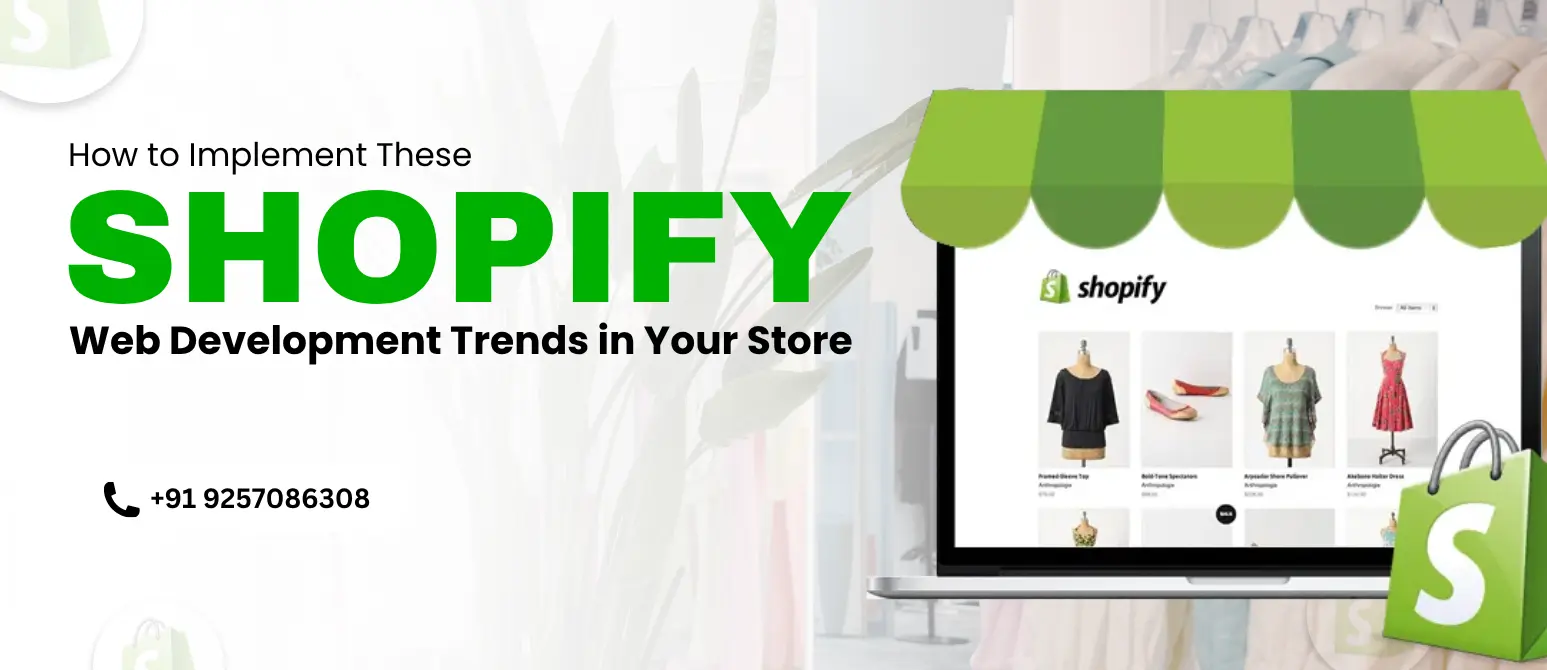
Key Talking Points to Cover:
- Audit Your Current Store: Remind readers to test their current Shopify store, page speed, experience, responsiveness, and sales. Connect to tools, such as Google PageSpeed, Hotjar, or Shopify analytics.
- Prioritize Based on Goals: All trends may not work in all stores. To illustrate, a fashion brand could have headless builds and AR as their main focus, whereas a digital goods brand would, perhaps, pay more attention to checkout optimization.
- Choose Scalable Tech Early: You should start with a scalable backend, a mobile-first (design and architecture), and a modular architecture that will support new features in the future.
- Don’t DIY Everything: Tutorials and themes are great, but actual results may require expertise, such as Hydrogen/Remix, personalized AI, or even checkout extensibility.
- Start Small, Iterate Fast: Even minor design implementations, such as a streamlined navbar or mobile reconstruction of the cart, can work wonders in terms of numbers. It is always better to make the changes to the design based on data rather than guesswork.
Why Choose DQOT Solutions for Shopify Web Development in 2025? 🚀
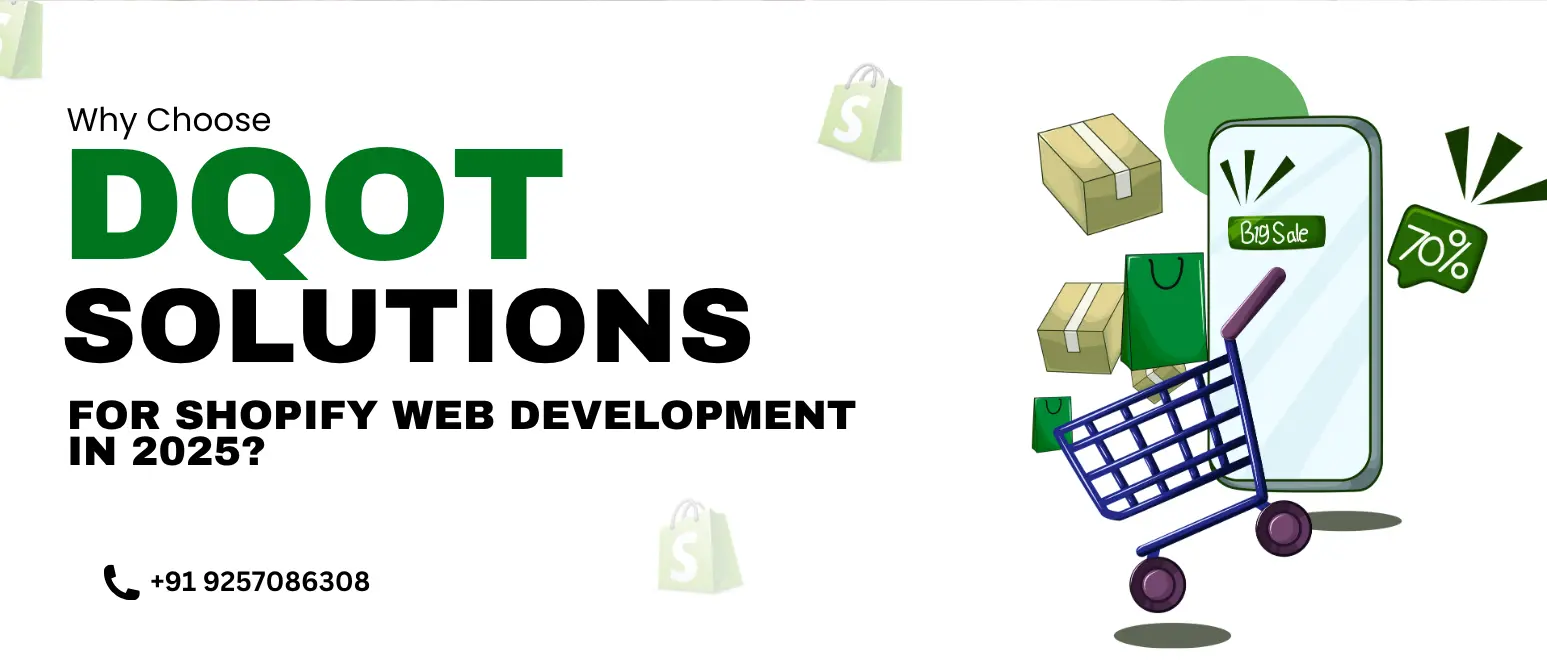
Why should you choose DQOT Solutions as your Shopify web development agency? There are thousands of other agencies around the world that do the same. Becoming a successful Shopify Web developer in 2025 goes beyond the shop-building utilitarian; it involves the creation of a series of high-converting digital experiences supported by strategy, innovation, and execution. That is what DQOT Solutions delivers.
1. Proven Expertise Across Industries
From fashion and wellness to SaaS and lifestyle, we’ve developed Shopify websites across domains with measurable results. Our portfolio features custom-built storefronts that load fast, engage customers, and scale with business needs.
2. Headless & Custom Development Capabilities
Whether you’re exploring Shopify’s Hydrogen + Oxygen, integrating AR for product previews, or looking to go fully headless, our dev team is ahead of the curve. We bring full-stack React/Remix capabilities to Shopify, delivering unique storefronts without compromising Shopify’s powerful backend.
3. Mobile-First, Conversion-Focused Design
At DQOT Solutions, Shopify mobile-first optimization is a core part of our development process. We prioritize Core Web Vitals, responsive layouts, and UX psychology to ensure that your users take action. Every pixel we place is backed by performance logic.
4. Transparent Communication & Project Management
Our clients trust us because we stay transparent. From strategy to delivery, our developers, designers, and Shopify consultants stay connected with you, sharing milestones, adapting to feedback, and optimizing workflows for timely completion.
5. End-to-End Shopify Services
We’re not just coders. We offer complete Shopify web development services, including:
- Custom Shopify theme design
- Shopify app integration
- Store migration
- SEO and performance audits
- CRO (Conversion Rate Optimization)
- Checkout customization
- AR/VR product implementation
- Shopify maintenance and support
Final Thoughts: Shopify Web Design in 2025, Where Strategy Meets Experience ✨
The future of Shopify web design in 2025 is all about making sure heads turn, conversion occurs more rapidly, and memorable experiences are provided to customers. Whether it is a performance-first mobile layout or an immersive 3-dimensional product page, the most successful brands are no longer retailing products; they are creating experiences.
The difference between a winning Shopify store and a cut-and-dried one is no longer how splendid it appears, but how intelligently it is constructed. An eye-catching UI, intelligent UX, SEO-friendly architecture, personalized product flows, and a high-performing checkout are the real drivers to scale up e-commerce these days. Design is no longer a touch-up layer; it’s a key growth driver.
That is where brands must look beyond default templates and invest in custom Shopify web development that will be in line with business objectives, customer behaviors, and active development of the platform. Regardless of how you intend to make your Shopify site, whether in the process of redesigning, migrating out of WooCommerce, or creating your first store, your Shopify website design will have a direct correlation with your success.
In DQOT Solutions, our design principles are purpose-driven. We combine technology with creativity to develop a dynamic and future-proof design, looking and doing more than just being pretty. We customize trends to you, establish a platform of growth, and collaborate on long-term performance.
2025 will not only see you survive the competitiveness but also outdesign, outconvert, and outsell it.
FAQs About Shopify Web Design 2025 ❓
Shopify web design deals with the visual and user experience, such as layout, branding, and navigation, whereas the development side deals with the functionality, performance, and integration. The best Shopify sites in 2025 weave them together to achieve the best effect.
The price depends on complexity. A simple custom design can begin at $2,000-$5,000, whereas a luxury, full-on custom store (with headless commerce, app integrations, and customized UX) can begin at a range of at least $10,000 and extend to over $50,000. DQOT Solutions provides customized Shopify website design packages to fit into budgets and range.
Absolutely. Shopify mobile optimization is paramount, as more than 70++ of the traffic is generated by smartphones. Mobile first design guarantees that pages load quicker, navigation can be tapped by a thumb, and check out flows are optimized for smaller screens, and all of those lead to higher conversion rates.
Shopify free themes are a good idea in case you are just starting, but serious businesses should think about a custom Shopify design. Custom design makes your site consistent with your brand, fast, user-friendly, and offers the ability to grow and be distinctive in a competitive market.
The most popular tools in 2025 include Figma (UI/UX mockups), Shopify CLI, Liquid templating, Shopify Polaris (admin UI), and headless builds with frameworks such as Hydrogen + Remix. After launch, we incorporate SEO, analytics, and performance tracking tools as well.
A Shopify website redesign can increase SEO when carried out correctly. It is all a matter of maintaining URLs, redirects, metadata, structured data, and speed performance. The design + SEO team at DQOT collaborates tirelessly to ensure your redesign increases traffic and trust.
We create and develop Shopify e-commerce websites for you or improve your existing one. This involves UI/UX design, theme building, app integration, optimization of performance, mobile-friendliness of the website, and post-launch assistance. We hope to help you make your store a high-conversion experience.
Seek an agency that has considerable experience in Shopify, in particular, a broad portfolio, quick response, and clarity of all processes. Technical agencies such as DQOT Solutions achieve this by combining both technical ability and design thinking to provide solutions that not only enlarge your store but also your revenue.


